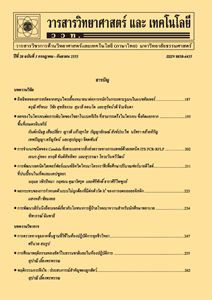การประยุกต์เครื่องอุ่นและแสดงอาหารด้วยรังสีอินฟราเรดเพื่อความปลอดภัยทางอาหารของผลิตภัณฑ์ชุมชน กรณีศึกษา : ข้าวหลาม
Main Article Content
Abstract
บทคัดย่อ
บทความนี้ที่มีวัตถุประสงค์เพื่อเสนอการประยุกต์เครื่องอุ่นและแสดงอาหารด้วยรังสีอินฟราเรดเพื่อความปลอดภัยของผลิตภัณฑ์อาหารจากชุมชน กรณีศึกษาข้าวหลาม โดยเครื่องที่นำเสนอได้ถูกออกแบบสำหรับบรรจุข้าวหลาม 20 กระบอก (กระบอกขนาดกลาง) อุปกรณ์หลัก คือ หลอดอินฟราเรดขนาด 500 วัตต์ จำนวน 4 หลอด และกระจกทนความร้อน วิธีการศึกษานี้แบ่งเป็น (1) การวัดการใช้พลังงานของเครื่อง อุณหภูมิของข้าวหลาม และอากาศภายในเครื่อง และ (2) การตรวจวิเคราะห์ปริมาณจุลินทรีย์และการสำรวจทัศนคติผู้บริโภค ผลการศึกษาพบว่าค่าพลังงานไฟฟ้าที่ใช้ไปประมาณ 9.3 kW-h ต่อการเปิดการทำงานของเครื่อง 7 ชั่วโมง อุณหภูมิเฉลี่ยข้าวหลามในเครื่อง 77.5 °C ผลการตรวจปริมาณจุลินทรีย์เมื่อเก็บตัวอย่างจำนวน 3 วัน ณ เวลาที่ 0, 3, 6, 24, 27, 30, 48, 51 และ 54 ชั่วโมง สำหรับข้าวหลามชุดที่หนึ่งที่ถูกเก็บไว้ในเครื่องอุ่นและแสดงอาหารนั้นตรวจไม่พบเชื้อจุลินทรีย์แม้เวลาผ่านไป 3 วัน นับจากวันที่ผลิต ในขณะที่สำหรับข้าวหลามชุดที่สองซึ่งเก็บไว้ที่อุณหภูมิห้องพบว่าจำนวนเชื้อจุลินทรีย์มีค่าเกินมาตรฐานความปลอดภัยทางอาหารเมื่อเก็บไว้เกิน 2 วัน นับจากวันที่ผลิต สำหรับผลสำรวจทัศนคติผู้บริโภคพบว่าร้อยละ 93 ของผู้ตอบแบบสอบถามมีความเห็นว่าการใช้งานเครื่องอุ่นและแสดงอาหารมีผลต่อการตัดสินใจซื้อผลิตภัณฑ์ต่อไปโดยส่งผลให้ตัดสินใจซื้อผลิตภัณฑ์ได้มากขึ้น
คำสำคัญ : ความปลอดภัยด้านอาหาร; ผลิตภัณฑ์ชุมชน; ข้าวหลาม; เครื่องอุ่นและแสดงอาหาร
Abstract
This article is to present an application of an infrared display warmer for community food products for a case study of the glutinous rice in the bamboo (Khao-lam). The project aims to improve the food safety for community products. The machine storage/display capacity is 20 (for the medium size). The machine mainly consists of infrared heating bulbs (4 pieces, 500 Watt each) and thermal resistant glasses. The study includes measuring the electrical energy consumption/average product/inside air temperatures, counting and analyzing a number of bacteria of the samples and surveying the customers’ opinions. It was found that the average energy usage for 7 hour operating was 9.3 kW-h, the average temperature was 77.5 °C. The results of bacteria counting for samples collecting for 3 days at 0, 3, 6, 24, 27, 30, 48, 51 and 54 hour show that the total number of bacteria in samples from the products stored at room temperature are over the food safety guideline after 2 days from the cooking date. While the samples from the products stored inside the display warmer has no significant number of bacteria. From the survey of customers’ opinions, 93 % of people being interviewed showed positive feedback on the usage of the display warmer, if the display warmer is used commercially, they will buy more products.
Keywords: food safety; community products; glutinous rice in the bamboo (Khao-lam); food display warmer


